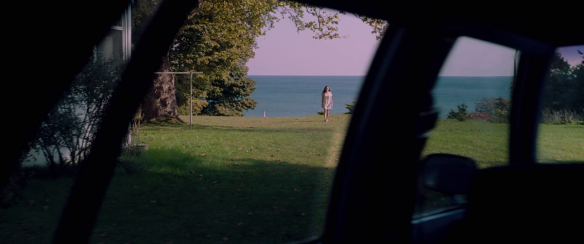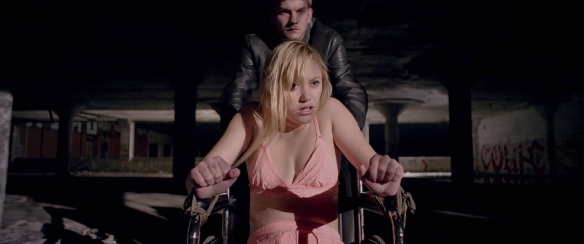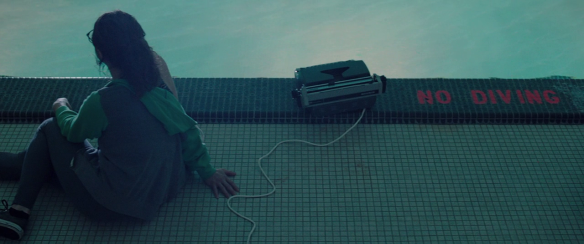 Remember the Scream movies? What was billed at the time as a series of knowing, witty take-downs of the slasher film genre, full of self-referential jokes and a spiralling plotline of ludicrously solemn fatalism, now looks like an arrogant attempt to speak on behalf of a genre and a generation, a nauseating spectacle that managed to pander to and sneer at its target audience in equal measure. David Robert Mitchell’s It Follows similarly tackles genre tropes, but without snarky citations. Instead, it sets out an intriguing premise (a slow-moving demon-thing, in multiple human forms, ceaselessly pursues any individual carrying its sexually transmitted curse, which can only be passed on to another person through sexual intercourse), and sticks to it. The film builds a distinctive atmosphere, bathes it in a throbbing, nagging electronic score, and never punctures the mood with the leavening hijinks that are routinely wedged into anything aimed at a teenaged audience. And since movies so rarely frighten me, I’m always happy to admit when it happens: It Follows is really scary. It has a plot like a ghost story told at an unusually mean-spirited sleepover, the sombre tone of a classmate’s funeral, and it lingers in the mind like a malicious rumour.
Remember the Scream movies? What was billed at the time as a series of knowing, witty take-downs of the slasher film genre, full of self-referential jokes and a spiralling plotline of ludicrously solemn fatalism, now looks like an arrogant attempt to speak on behalf of a genre and a generation, a nauseating spectacle that managed to pander to and sneer at its target audience in equal measure. David Robert Mitchell’s It Follows similarly tackles genre tropes, but without snarky citations. Instead, it sets out an intriguing premise (a slow-moving demon-thing, in multiple human forms, ceaselessly pursues any individual carrying its sexually transmitted curse, which can only be passed on to another person through sexual intercourse), and sticks to it. The film builds a distinctive atmosphere, bathes it in a throbbing, nagging electronic score, and never punctures the mood with the leavening hijinks that are routinely wedged into anything aimed at a teenaged audience. And since movies so rarely frighten me, I’m always happy to admit when it happens: It Follows is really scary. It has a plot like a ghost story told at an unusually mean-spirited sleepover, the sombre tone of a classmate’s funeral, and it lingers in the mind like a malicious rumour.
 So, while the Scream films had their cake and stabbed it in the neck by both mocking the silliness of teenagers in horror films and marshalling a cast of very silly teenagers, It Follows has a real feeling for its protagonists’ anxieties. While Scream (you can probably tell I hate those movies, and this is, I promise the last time I’ll use them as a strawman, or even mention them at all…) wrote out the “final girl” trope in big crayons, because it just seemed, like, totally stoopid that horror films should enshrine psychosexual terrors in popular culture, It Follows takes the trope seriously: if slasher movies have traditionally punished the promiscuous and heroised the virginal, this is one film that wants not to mock but to find out why. It takes the stigma and anxiety of teen sexuality and blows it up to a full-on horror trope in its own right. Of course, plenty of horror movies are about teen sex and the punishments that come to its practitioners from primitively moral killers. But It Follows reifies that sexuality into a deathly contagion: victims are confronted with a lethal double standard, sex is what gives them the curse, but also what staves it off.
So, while the Scream films had their cake and stabbed it in the neck by both mocking the silliness of teenagers in horror films and marshalling a cast of very silly teenagers, It Follows has a real feeling for its protagonists’ anxieties. While Scream (you can probably tell I hate those movies, and this is, I promise the last time I’ll use them as a strawman, or even mention them at all…) wrote out the “final girl” trope in big crayons, because it just seemed, like, totally stoopid that horror films should enshrine psychosexual terrors in popular culture, It Follows takes the trope seriously: if slasher movies have traditionally punished the promiscuous and heroised the virginal, this is one film that wants not to mock but to find out why. It takes the stigma and anxiety of teen sexuality and blows it up to a full-on horror trope in its own right. Of course, plenty of horror movies are about teen sex and the punishments that come to its practitioners from primitively moral killers. But It Follows reifies that sexuality into a deathly contagion: victims are confronted with a lethal double standard, sex is what gives them the curse, but also what staves it off.
 A lesser horror film would have made easy mistakes: creating some ancient mystical motivation for the curse; featuring parents or other authority figures; wisecracking sidekicks; pop soundtrack. It Follows creates an atmosphere and then maintains it, without undercutting or subverting the tension. There’s a close-quarters sensuality to many shots that puts us right next to our central subject, Jay Height (Maika Monroe).
A lesser horror film would have made easy mistakes: creating some ancient mystical motivation for the curse; featuring parents or other authority figures; wisecracking sidekicks; pop soundtrack. It Follows creates an atmosphere and then maintains it, without undercutting or subverting the tension. There’s a close-quarters sensuality to many shots that puts us right next to our central subject, Jay Height (Maika Monroe).


 Note, for instance, the early scene where she observes the critters from her backyard swimming pool, and makes the easy decision to drown an ant on her arm: hands are prominent in many shots, too, a poignant rendering of a world both perceived through, and jeopardised by, the necessity of touch. This is not an unusual neorealist technique to create a sense of immediacy, but it is absolutely the right choice for this film: aligning us with Kelly makes it all the more frightening, since whatever is coming for her must also be coming for us, and we don’t get to observe her from a safe distance. We scan the environment for approaching death just as she does, and the often shallow focus frustrates that task; rarely has often screen space been so actively weighted with dread.
Note, for instance, the early scene where she observes the critters from her backyard swimming pool, and makes the easy decision to drown an ant on her arm: hands are prominent in many shots, too, a poignant rendering of a world both perceived through, and jeopardised by, the necessity of touch. This is not an unusual neorealist technique to create a sense of immediacy, but it is absolutely the right choice for this film: aligning us with Kelly makes it all the more frightening, since whatever is coming for her must also be coming for us, and we don’t get to observe her from a safe distance. We scan the environment for approaching death just as she does, and the often shallow focus frustrates that task; rarely has often screen space been so actively weighted with dread.
 One strange aspect of the film is its placement in time. Musically and thematically, it’s in conversation with the 1980s. The TV screens seems to show only 1950s science fiction B-movies. This is probably a deliberate strategy to avoid pinning the film down to a specific temporal location, but it also shows us how genres cyclically (50s, 80s, now) latch onto the things they find unnerving (commies/conformity, sex/knives, sex/intimacy). It does mean that a film that clearly wants to talk about young people now, is devoid of the iconography of social media. And yet, it is fundamentally a film about sharing.
One strange aspect of the film is its placement in time. Musically and thematically, it’s in conversation with the 1980s. The TV screens seems to show only 1950s science fiction B-movies. This is probably a deliberate strategy to avoid pinning the film down to a specific temporal location, but it also shows us how genres cyclically (50s, 80s, now) latch onto the things they find unnerving (commies/conformity, sex/knives, sex/intimacy). It does mean that a film that clearly wants to talk about young people now, is devoid of the iconography of social media. And yet, it is fundamentally a film about sharing.

 Probably more profound than the film’s metaphor of sexual stigma as a killer curse is the way characters react to the threat, by having sex in order to share their fear. For some in this film, without giving too much away, knowing a potential partner is scared is an opportunity to exploit their sexuality, while others have an altruistic wish to take on the curse on behalf of a friend. But it’s a complicated picture, and ends with a couple unsure of what they’ve done or how scared they should be, anxious that everybody be as cursed as they are, and knowing that they can never be free, just threatened together. It’s a film not about why we hide our shame, but about why we find security in sharing it with someone, anyone else.
Probably more profound than the film’s metaphor of sexual stigma as a killer curse is the way characters react to the threat, by having sex in order to share their fear. For some in this film, without giving too much away, knowing a potential partner is scared is an opportunity to exploit their sexuality, while others have an altruistic wish to take on the curse on behalf of a friend. But it’s a complicated picture, and ends with a couple unsure of what they’ve done or how scared they should be, anxious that everybody be as cursed as they are, and knowing that they can never be free, just threatened together. It’s a film not about why we hide our shame, but about why we find security in sharing it with someone, anyone else.

Tag Archives: sexuality
Picture of the Week #35: Sixty Sexy Movie Posters
If ever there was a post that was self-explanatory, it’s this one. I’ve tried to select a few orthodox images amongst the less well-known films and posters, all linked by the ways they use sexual imagery to sell films even when sexuality may only be a small component of the films themselves. View as a slideshow above, or scroll down and click on the thumbnails for a larger view.
[See more of my galleries here.]
Funeral Parade of Roses
“A feverish collision of avant-garde aesthetics and grindhouse shocks (not to mention a direct influence on Stanley Kubrick’s A Clockwork Orange), Funeral Parade of Roses takes us on an electrifying journey into the nether-regions of the late-’60s Tokyo underworld.
Cross-dressing club-kid Eddie (played by real-life transvestite entertainer extraordinaire Peter, famed for his role as Kyoami the Fool in Akira Kurosawa’s Ran) vies with a rival drag-queen (Osamu Ogasawara) for the favours of drug-dealing cabaret-manager Gonda (Yoshio Tsuchiya, himself a Kurosawa player who appeared in such films as Seven Samurai, Throne of Blood, and High and Low). Passions escalate and blood begins to flow – before all tensions are released in a jolting climax.” (Plot Synopsis from Lovefilm.com)
It’s tempting not to review this film, but just to show a bunch of stills and leave them to stand alone as a recommendation to view the whole thing. Almost any frame can be grabbed and held up as a beautifully composed image, but mostly it becomes fascinating for the barrage of eclectic formal experiments.
While these stills show the exciting variety of shot scales and compositional spectacles, they don’t convey the ways in which the mash-up of documentary and fictional techniques drives the film forward. The film provides a mix of extreme narrative contrivance and naturalistic, Brechtian interview with ordinary people and cast members out of character. Peter’s interview to camera even hints at the plot twist which has not yet been revealed. Matsumoto wanted to blend together his disparate cinematic influences; he hails from a documentary background, but was fascinated by Italian neo-realism and the avant-garde, and each of these modes complements, comments on or occasionally undermines the others. Moments of apparently naturalistic documentary footage give way to blatant fabrication and vice versa. At every step, the fiction is undermined by images of its construction. Scenes are linked with bursts of leader film or still images. A sex scene focusing on Eddie’s ecstatic facial expressions is cut short by a shot of the scene being filmed, revealing that he is writhing alone on the bed. Is this scene telling us that Eddie is acting in adult films, or is it an entirely self-reflexive insert to puncture the fictional bubble? Even his final scene of self mutilation is interrupted by a contact shot of stills of the scene being shot, and a cheerful commentator who asks the viewer: “Frightening, isn’t it?”
Whatever it did for progressing the prominence of gay people in Japan, this is less a piece of authentic queer cinema and more an example of captivated sub-cultural tourism. The transvestite body is treated as a fascinating object, shot in fragments during sex scenes, and its always a surprise to see the lead character out of make-up; the camera seems to revel in the illusion that Eddie’s face creates. The pleasured look on his face, the gripped sheets, clutched necks, scraped backs and intertwined fingers would look like the average hetero sex scene if they weren’t dressed up in the garb of queer cinema. Maybe that kind of passing is the whole point of the film, but rather than allowing the queens the indulgence of full immersion in their masquerade, the film thematises the wearing of masks as a universal human trait to hide our true selves. Many scenes draw comic effect from the incongruity of pretty girls who are also prey to the inconveniences of guy stuff:
In addition, Eddie’s traumatic past comes worryingly close to claiming a correlation between incestuous child abuse and homosexuality, but these are minor reservations for an otherwise electrifying, exploratory film that keeps turning up one flourish of visual wit after another.
Read more:
Jasper Sharp, “Funeral Parade of Roses.”
Review at Cinema Strikes Back.
Review at Lucid Screening.
Review by Kevin Wilson at Thirtyframesasecond.


















































































